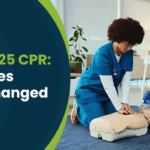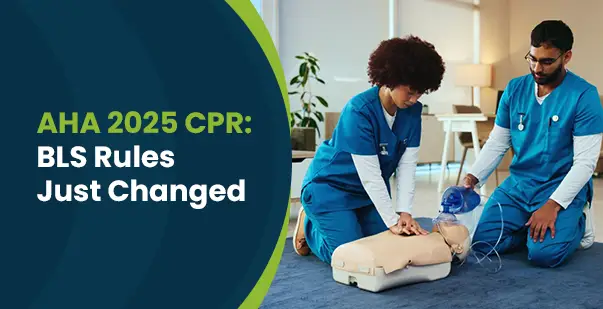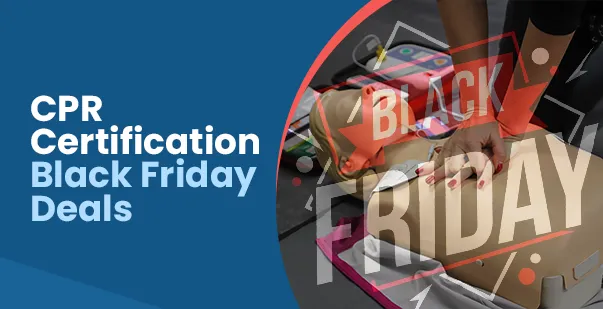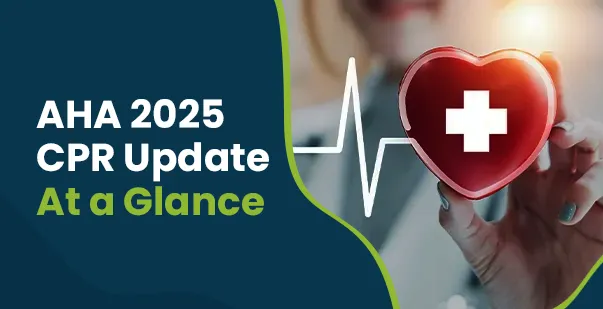Imagine witnessing one of your colleagues collapse at work and becoming unresponsive. The reason could be sudden cardiac arrest, which is one of the leading causes of fatalities worldwide. In fact, the American Heart Association states that over 436,000 Americans die from cardiac arrest in a year. This means it claims more lives than any other disease, like cancer, influenza, or pneumonia. With this, there is an increased requirement for healthcare professionals who are proficient in assisting the victims of cardiac arrest.
Most importantly, these people must be well-versed in cardiopulmonary resuscitation (CPR). It’s a technique that involves giving chest compressions and using an automated external defibrillator (AED) to revive the victim. Performing CPR immediately can double or triple the chances of a victim’s survival. In this guide, we will discuss how to be CPR-certified so that you can help victims in real-life emergencies.
How to Get CPR Certified?
If you want to equip yourself with the latest healthcare and first-aid skills, the best thing to do is to enroll in a CPR certification. So, follow the steps when starting the process, as mentioned below:
Step 1. Find Accredited Training Providers
Choose an accredited provider like the American Health Care Academy that is recognized by employers and regulatory authorities in the United States or worldwide. These organizations set the gold standard in CPR training to ensure that what you learn aligns with the latest medical guidelines.
Step 2. Enroll in a CPR Course
Enroll in the online CPR course that best suits your needs. However, it’s important to choose the right course based on your background. Remember that the basic CPR certification is available for the general public. On the other hand, advanced courses like Basic Life Support (BLS) are best suited for experienced healthcare professionals.
Step 3. Learn the Primary Topics
You will learn how to perform chest compressions, deliver rescue breaths, and use an Automated External Defibrillator (AED) during the initial training. Proper compressions should be at least 2 inches deep for adults, about 2 inches for children, and about 1.5 inches for infants, all at a rate of 100–120 per minute.
Step 4: Complete Online Modules
Various interactive lessons, instructional videos, and quizzes can be implemented across the online training sessions. These modules cover topics like identifying cardiovascular diseases and even using an AED. The flexible format allows you to learn at your own pace. Interactive learning has also transformed CPR education by making it more engaging, realistic, and effective.
Step 5: Attend Skills Evaluation Sessions
Many programs include an in-person skills test after you have completed your online learning sessions. This important step on how to be CPR-certified verifies that you can correctly perform the acts when someone is in danger. The real-life skills demo is also a legal and professional requirement in several states. Successfully passing both the theory and practical portions earns you your certification.
Step 6: Earn Your Certification Card
At the end of your course, you must take a skills test and sometimes a short written exam. If you pass these assessments, it proves your competence and earns you a certification card for one to two years. Nowadays, several training providers also issue digital certification cards that you can download instantly.
Read More: Why CPR Training Matters for Senior Caregivers
Is It Okay to Get CPR-certified Online?
Knowing how do you become CPR-certified is not enough. You must also know the correct format of training that best suits your current needs. Today, most people recommend enrolling in online courses. But is it the right choice? Let’s explore below.
The Rise of Online Certification
Online CPR certification promotes a safer working environment, especially due to the latest advancements in technology. This allows learners to study theory modules and also attend exams from the comfort of their homes. Hence, those with busy schedules or limited access to proper training centers can easily access the certification online.
Hybrid Models for Practical Skills
You can easily master theory online, but the same cannot be said about hands-on practice. That is why many accredited providers offer hybrid courses. As a part of these sessions, you can easily complete online modules and attend a brief in-person skills session. As a result, you can develop both the knowledge and muscle memory required to perform CPR effectively. Meanwhile, several online options also involve the usage of real-life simulations with AR/VR technology for better skill enhancement.
Employer Recognition of Online Certifications
Always check your employer’s or regulatory body’s requirements before choosing an online-only course. Employers, such as hospitals, clinics, or schools, usually accept online certifications if offered by accredited providers. Sometimes, they may also require proof of hands-on training.
Can You Get CPR-Certified Online for Free?
You may find several training providers that offer you the CPR certification after paying a nominal fee and taking the course. However, not everyone may be able to afford the expenses or want to spend some extra money on additional certifications. This often highlights the importance of making lifesaving training more equitable and accessible.
The question is – how do I become CPR-certified for free? Is there an opportunity available across any platform? Here’s what you should know:
Availability of Free Resources
You can easily access free CPR training videos and quizzes online across various platforms in the United States. These resources can be an excellent source of awareness and also allow you to learn the basics instantly. However, you do not get any official certification card recognized by any potential employers or institutions through these sessions.
Free Trials and Introductory Courses
You may find some trial courses that allow you to access training materials at no cost. These introductory resources are useful only for beginners because they help you get familiar with CPR concepts. However, you will usually need to pay for the final exam and practical assessment to receive the certification.
Risks of Depending on Free Certification
Free certifications may not hold up in professional or legal situations, especially if they are not accredited by any recognized body. Of course, they can be helpful for personal knowledge. However, these courses can never replace the value of training through a recognized provider. So, you must balance your cost savings with credibility and skill readiness.
Limited Free Options
CPR training always requires qualified instructors and materials. That is why the availability of free CPR certifications is quite rare. However, you may still find a few free classes sponsored by nonprofit organizations or community initiatives during health awareness campaigns. Remember that the opportunities also vary depending on your location and availability.
Employer-Sponsored Training
A few workspaces may specifically cover the cost of CPR certification for their employees. This is especially common in healthcare, education, and childcare industries, where CPR is a regulatory requirement. Asking your employer about reimbursement or sponsored programs can also save you money.
Community-Based Initiatives
Local health departments, schools, and NGOs occasionally organize free CPR workshops. These sessions may provide participants with a certification card at no cost. Staying informed about community health events can help you take advantage of these opportunities. For example, the Chicago Department of Public Health frequently partners with local hospitals to host free CPR training days for residents.
Read More: CPR, First Aid & ADA With Course Accessibility Features
How Long Does It Take to Get CPR Certified?
Becoming CPR-certified becomes easier if you know how long it takes to complete the course. The duration of your CPR certification often depends on the specific course format. It can be either in-person, hybrid, or completely online, based on your needs. Let’s take a look at the detailed timelines below:
Course Duration
A standard online CPR certification course generally takes 2–4 hours, while a BLS course for healthcare providers may take 4–6 hours. This includes both theoretical lessons and hands-on practice. Some advanced certifications, like the BLS, may take longer, especially if they cover extra skills such as airway management.
Online vs. In-Person Timelines
You can easily complete the theory portion at your own pace with online courses, sometimes in just a couple of hours. However, hybrid courses require scheduling an in-person session, which may add a day or two to the process. The flexibility of online learning makes certification more manageable, especially if you are a busy professional.
Certification Validity and Renewal
Most CPR certifications are valid for two years. Later, you must take a renewal course to maintain your credentials over time. Renewal courses are quite shorter than initial training and focus on updating skills and knowledge based on the latest guidelines. Currently, many providers also send reminders regarding your certification expiry date.
What to Do If You Fail a CPR Course?
Many people don’t pass the exam for CPR certification on their first attempt, and that’s okay. Most of them fail because of common errors like mentioning the wrong depth, wrong rhythm, or incomplete release. It just means you need more practice and preparation. According to AHA or Red Cross policies, you can also retake the written test and skills evaluation within a specified period.
Here’s what you can do to make the most of your next attempts:
Understand Why You Didn’t Pass
Most CPR courses test two components: a written exam and a practical skills test. Ask your instructor for feedback. Did you miss key theory questions? Were your compressions not deep enough or too slow? Knowing where you fell short will help you improve.
Retake Options Are Available
Failing once doesn’t mean you’re out. Both the American Heart Association (AHA) and the American Red Cross allow you to retake the CPR skills test at no extra cost, often on the same day or within 30 days. In most cases, you only need to repeat the section you didn’t pass instead of retaking the entire course.
Practice Before Retesting
Use online resources from the American Heart Association or Red Cross, practice quizzes, and if possible, rehearse on a manikin to improve compression depth and rhythm. Focus especially on your weak areas.
Manage Test Anxiety
Sometimes failure happens because of nerves, not knowledge. Simple breathing techniques and practice can help you feel calmer during your retest. Please note that some learners often do better in small group sessions instead of big classrooms.
Take the Next Step Toward CPR Certification
You can get CPR certified easily in 2025. The process is quite flexible because you get to access online and hybrid learning options. While free resources also exist, you must always choose accredited certification, as they remain the gold standard for both personal confidence and professional requirements. You can go for either in-person or online training to learn the key skills and act during emergencies.
Most importantly, knowing how to be CPR-certified could one day save a life. Enroll in an AHA-accredited online CPR course to gain the skills and certification recognized across the U.S., and be ready to save a life.









